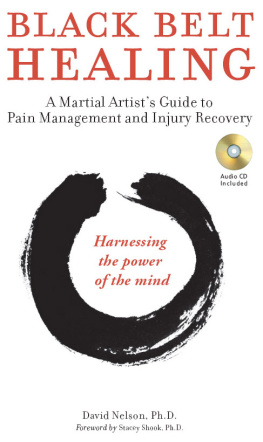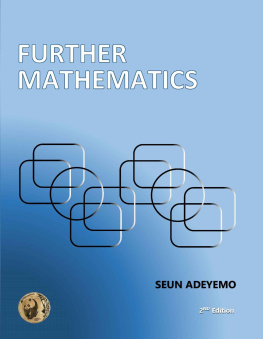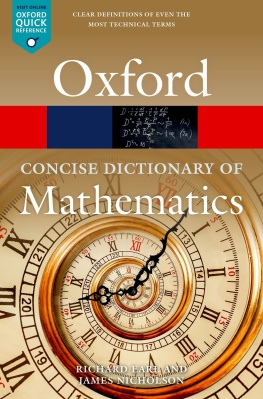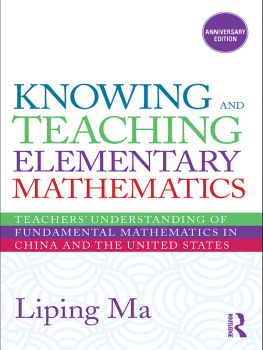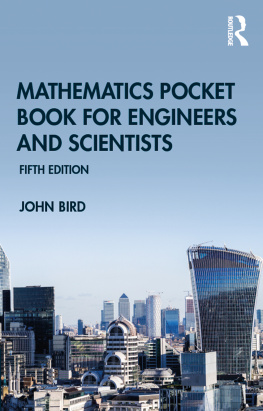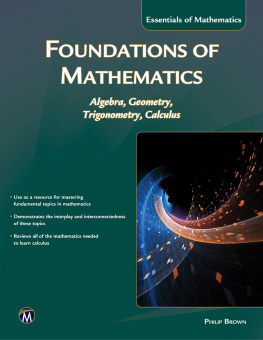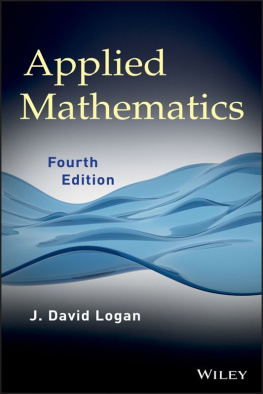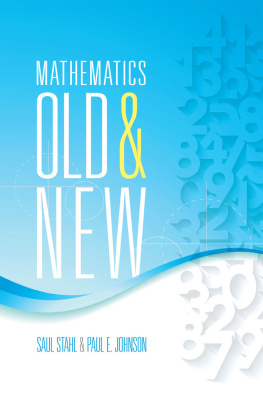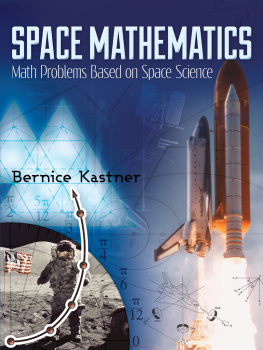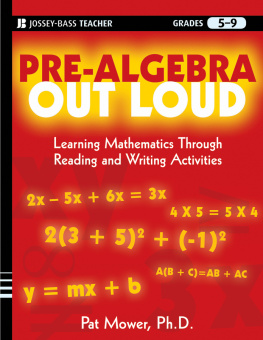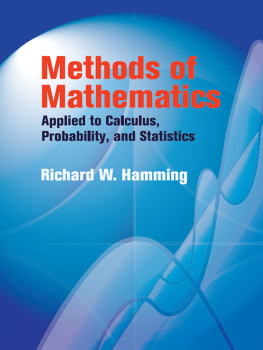PENGUIN REFERENCE
The Penguin Dictionary of Mathematics
David Nelson, born in 1938, was educated at Calday Grange Grammar School, Cheshire, and Christs College, Cambridge. After postgraduate studies in mathematical logic at Cambridge and Bristol Universities, he entered the teaching profession. He has published papers in mathematical journals and is a Fellow of the Institute of Mathematics and its Applications.
He was a lecturer at the University of Manchester from 1981 to 2001, specializing in mathematical cognition and the history of mathematics. He is now an Honorary Fellow. His publications include Extensions of Calculus, Multicultural Mathematics and The Penguin Dictionary of Statistics. He has lectured in Poland, Italy, France and the USA, and in 1995, at the invitation of the State Education Committee of the Peoples Republic of China, organized and led a three-week National Seminar on Mathematics Education to initiate reform of the Chinese national mathematics curriculum.
A former member of the National Youth Orchestra, his main recreations are playing the flute and the piano. He also enjoys gardening and golf. His wife, Gillian, is a writer and they have three children.
FOURTH EDITION
The Penguin Dictionary of
MATHEMATICS
Edited by David Nelson

PENGUIN BOOKS
PENGUIN BOOKS
Published by the Penguin Group
Penguin Books Ltd, 80 Strand, London WC2R 0RL , England
Penguin Group (USA) Inc., 375 Hudson Street, New York, New York 10014, USA
Penguin Group (Canada), 90 Eglinton Avenue East, Suite 700, Toronto, Ontario, Canada M4P 2Y3 (a division of Pearson Penguin Canada Inc.)
Penguin Ireland, 25 St Stephens Green, Dublin 2, Ireland (a division of Penguin Books Ltd)
Penguin Group (Australia), 250 Camberwell Road, Camberwell, Victoria 3124, Australia (a division of Pearson Australia Group Pty Ltd)
Penguin Books India Pvt Ltd, 11 Community Centre, Panchsheel Park, New Delhi 110 017, India
Penguin Group (NZ), 67 Apollo Drive, Rosedale, North Shore 0632, New Zealand (a division of Pearson New Zealand Ltd)
Penguin Books (South Africa) (Pty) Ltd, 24 Sturdee Avenue, Rosebank, Johannesburg 2196, South Africa
Penguin Books Ltd, Registered Offices: 80 Strand, London WC2R 0RL , England
www.penguin.com
First published 1989
Second edition 1998
Third edition 2003
Fourth edition 2008
1
Copyright Penguin Books Ltd, 1989, 1998, 2003, 2008
All rights reserved
The moral right of the author has been asserted
Except in the United States of America, this book is sold subject to the condition that it shall not, by way of trade or otherwise, be lent, re-sold, hired out, or otherwise circulated without the publishers prior consent in any form of binding or cover other than that in which it is published and without a similar condition including this condition being imposed on the subsequent purchaser
ISBN: 978-0-141-92087-0
SPECIALIST CONTRIBUTORS TO THE SECOND, THIRD, AND FOURTH EDITIONS
DEREK GJERTSEN University of Liverpool
NICK HIGHAM University of Manchester
TERENCE JACKSON Open University
MARK POLLICOTT University of Warwick
ELMER REES University of Bristol
PETER SPRENT University of Dundee
Derek Gjertsen was a Lecturer in Philosophy at the University of Ghana and then an Honorary Research Fellow at the University of Liverpool. He died in 2008.
Nick Higham is Richardson Professor of Applied Mathematics at the University of Manchester and a Fellow of the Royal Society.
Terence Jackson was a Senior Lecturer in Mathematics at the University of York and is now an Associate Lecturer at the Open University.
Mark Pollicott is a Professor of Mathematics at the University of Warwick.
Elmer Rees is Director of the Heilbronn Institute for Mathematical Research at the University of Bristol and Emeritus Professor of Mathematics, University of Edinburgh.
Peter Sprent is Emeritus Professor of Mathematics (Statistics), University of Dundee.
Preface to the Fourth Edition
The Penguin Dictionary of Mathematics aims to provide school and university students with concise explanations of mathematical terms. It tries to cover all the branches of mathematics, both pure and applied, and to include entries and examples that will be helpful to scientists and others who use mathematics in their work. It is hoped that it will also be a useful reference source for non-specialists. Terms used in computer science are not included unless they are of particular mathematical interest.
The dictionary now contains over 3750 headwords, including over 200 biographies of important mathematicians. Chinese names are given in both the modern Pinyin and the older Wade-Giles form (e.g. Beijing/Peking). Diagrams are provided where they help with the understanding of a term.
There is a network of cross-references. Some entries simply refer the reader to another entry. This may indicate that the terms are synonyms, as with prime pairSee . Alternatively it may indicate that the first term is more conveniently discussed or defined within the entry for the second term, in which case the first term is printed in italics within the entry for the second term, as with bisectorSee bisect. An asterisk placed before a term, as in *prime, indicates that this term has its own entry in the dictionary which will provide additional information. Reference is also made to the tables in the Appendix. One of these, Table 7, is designed to help the reader find entries where common signs or symbols such as or are explained.
The first edition of the dictionary had ten specialist contributors: Jane Farrill Southern, George Galfalvi, Derek Gjertsen, Valerie Illingworth, Alan Isaacs, Terence Jackson, Richard Maunder, Margaret Preece, Peter Sprent and Ian Stewart; and it was co-edited by John Daintith and the present editor. Each subsequent edition has had the team of six specialist contributors listed on the previous page, and been edited by the present editor. The preparation of each of these editions has provided an opportunity to revise, update, and expand the work in accordance with its overall aims, taking into account the many helpful comments and suggestions made by reviewers and correspondents. In particular, for this fourth edition, increased coverage is given to the area of coding theory.
The editor is deeply grateful to the present team of specialist contributors, three of whom have worked on every edition, for their cooperative dedication to the project. As well as cheerfully drafting and redrafting new or revised entries they have also commented helpfully on the editors own contributions. He is also thankful for help, advice, and comments from Francis Coghlan, Philip Davis, Raymond Lickorish, James McKee, Peter Milligan, Peter Neumann and Jeff Paris. Thanks are also due to two former editors at Penguin, Donald McFarlan and Ravi Mirchandani, for their support of the first two editions, and to David Duguid, Caroline Pretty, Ellie Smith and Ruth Stimson for seeing the four books through the press. Finally, we are greatly indebted to our copy-editor, John Woodruff, whose expertise and unwavering tenacity have improved every edition.
David Nelson, 2008
Contents
A
An Symbol for the *alternating group for a set of n elements.
Abel, Niels Henrik (180229) Norwegian mathematician noted for his proof (1824) that the general quintic equation is unsolvable algebraically. Also important were his work in the field of elliptic and transcendental functions, and on the convergence of infinite series, and his publication of the first rigorous proof of the binomial theorem.
Next page


